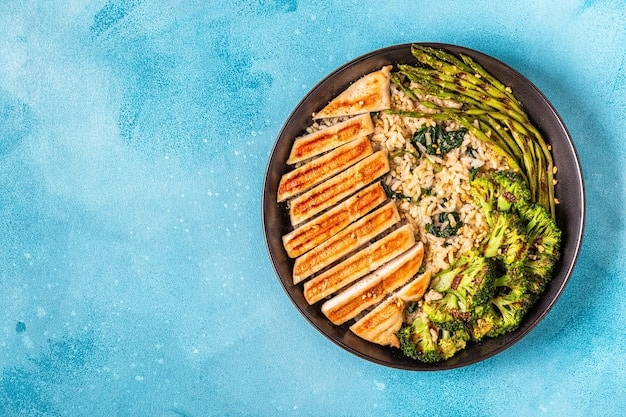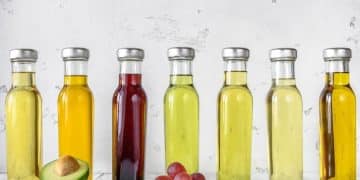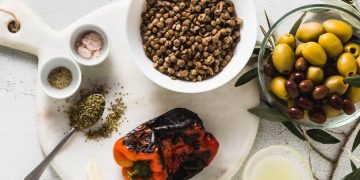3 Simple Strategies to Cut Down on Sodium by 20% This Month

Achieving a 20% reduction in sodium intake within a month is attainable by focusing on three core strategies: becoming a vigilant label reader, prioritizing whole and unprocessed foods, and mastering the art of low-sodium cooking through herbs, spices, and acid.
Embarking on a journey to improve dietary habits often involves navigating a complex landscape of nutritional advice. Among the most impactful changes one can make is moderating sodium intake, a crucial step for cardiovascular health and overall well-being. This article specifically outlines 3 Simple Strategies to Cut Down on Sodium Intake by 20% This Month, offering actionable insights for a healthier lifestyle. The goal isn’t just reduction, but sustainable dietary shifts that promote well-being without sacrificing flavor or enjoyment.
Understanding Sodium’s Role and Why Less is More
Sodium, often synonymous with salt, is an essential nutrient performing vital bodily functions such as maintaining fluid balance and nerve impulses. However, in contemporary diets, particularly in the US, excessive sodium consumption has become a pervasive issue. The average American consumes significantly more than the recommended daily limit, primarily from processed and restaurant foods. This overconsumption is directly linked to elevated blood pressure, a leading risk factor for heart disease and stroke.
Reducing sodium isn’t about bland food; it’s about re-educating your palate and understanding where sodium hides. Often, the salt we add at the table is a minor contributor compared to the sodium already present in packaged and prepared foods. A conscious effort to cut down can have profound health benefits, improving arterial flexibility, reducing fluid retention, and easing the burden on your kidneys. This initial step of understanding is foundational to implementing any effective strategy for reduction.
The Hidden Dangers of Excess Sodium
While a certain amount of sodium is vital for the body, the reality of modern diets means most people consume far too much. This excess is not benign; it is a silent contributor to a host of serious health conditions. Understanding these risks can serve as a powerful motivator for making sustained dietary changes.
- 📈 Hypertension: Chronic high sodium intake is a primary driver of high blood pressure, straining blood vessels and increasing the risk of heart attacks and strokes.
- 💔 Heart Disease: Over time, high blood pressure can damage arteries, making them less elastic and leading to cardiovascular diseases.
- 💧 Fluid Retention: Sodium makes the body hold onto water, leading to bloating and swelling, particularly in the hands, feet, and ankles.
- কিডney Strain: The kidneys work hard to filter excess sodium from the blood. Prolonged high intake can overwhelm them, potentially leading to kidney disease.
Reducing sodium intake is not merely a dietary adjustment; it’s a proactive measure for safeguarding your long-term health. By making informed choices, individuals can significantly mitigate these risks and contribute to overall wellness. The journey towards lowering sodium intake is an investment in a healthier future, impacting not just physical health but also subjective well-being and energy levels daily.
Sodium vs. Salt: Clarifying the Concepts
It’s common to use the terms “sodium” and “salt” interchangeably, but there’s a nuanced distinction that’s important for dietary management. Sodium is a mineral element, while salt is a compound known chemically as sodium chloride. Approximately 40% of salt by weight is sodium. When we talk about sodium intake in the context of health, we are generally referring to the sodium content within the food, whether it comes from added salt or naturally occurring sources.
Understanding this difference is key to deciphering food labels and making accurate dietary adjustments. Reducing “salt” is a significant part of the strategy, but it’s the total “sodium” content that ultimately impacts health. Many foods, especially processed ones, contain high levels of sodium without necessarily tasting overtly salty, making label reading an indispensable skill for effective reduction.
Strategy 1: Become a Vigilant Label Reader
One of the most effective ways to slash sodium intake is to become a discerning consumer, starting with the Nutrition Facts label. This isn’t just about glancing at the numbers; it’s about understanding what they mean and how to make informed comparisons. Many people are surprised to find the high sodium content in seemingly benign foods like bread, cereals, and even sweet treats.
The key metric to look for is the daily value (DV) for sodium. A food is considered low in sodium if it contains 5% DV or less per serving, and high if it contains 20% DV or more. Aiming for options in the lower range significantly contributes to your 20% reduction goal. This strategy requires a shift in mindset from simply checking ingredients to actively seeking out lower-sodium alternatives across all food categories.
Deciphering the Nutrition Facts Label
The Nutrition Facts label on packaged foods is your primary tool for managing sodium intake. It provides critical information that, once understood, empowers you to make healthier choices and effectively contributes to reducing your sodium consumption by 20% within a month.
- 📊 Serving Size: Always check the serving size first. All the nutritional information, including sodium, is based on this amount. Many packages contain multiple servings, so multiply the sodium content accordingly.
- 🧂 Sodium Content: Locate the “Sodium” line in milligrams (mg). The recommended daily limit is generally 2,300 mg, but for some, like those with hypertension, it’s lower (1,500 mg).
- % Daily Value (%DV): This percentage tells you how much of a nutrient in a serving contributes to a daily diet. For sodium, 5% DV or less per serving is considered low, and 20% DV or more is considered high. Aim for foods with a lower %DV for sodium.
- Ingredients List: Sodium can hide under many names. Look out for “sodium” followed by another word (e.g., sodium bicarbonate, sodium nitrite), “salt,” “soda,” “brine,” and even terms like “MSG” or “disodium guanylate,” which contain sodium.
By systematically reviewing these elements, you can quickly identify high-sodium culprits and select healthier alternatives. This practice becomes faster and more intuitive over time, eventually becoming a natural part of your grocery shopping routine. It’s a fundamental shift towards more conscious eating that supports your healthier lifestyle goals effectively.

Spotting Hidden Sodium in Everyday Foods
Sodium isn’t just in overtly salty foods like chips or cured meats. It lurks in a surprising array of everyday products, making it challenging to reduce intake without careful attention. Identifying these hidden sources is paramount for reaching your 20% reduction target within the month.
- 🍞 Breads and Bakery Items: Many types of bread, rolls, and pastries contain significant amounts of sodium, used for flavor, texture, and as a leavening agent.
- 🥫 Canned Goods: Canned soups, vegetables, and beans are often packed with sodium for preservation and flavor. Opt for “no salt added” or “low sodium” versions, and rinse regular canned beans before use.
- 🧀 Cheeses: Processed cheeses, cottage cheese, and many natural cheeses can be surprisingly high in sodium.
- 🥣 Breakfast Cereals: Even seemingly healthy cereals can contribute to your daily sodium count. Always check labels.
- 🧂 Condiments and Sauces: Ketchup, mustard, salad dressings, soy sauce, and many marinades are notoriously high in sodium. Consider low-sodium alternatives or making your own.
Understanding these less obvious sources of sodium empowers you to make smarter choices at the grocery store and when preparing meals. It highlights that sodium reduction is not just about avoiding the salt shaker, but about being aware of the entire dietary landscape. This proactive approach ensures that your efforts are comprehensive and impactful.
Strategy 2: Prioritize Whole and Unprocessed Foods
The vast majority of sodium in the American diet comes from processed foods, not from the salt shaker. This fact underscores the importance of the second strategy: shifting your diet towards whole, unprocessed foods. When you emphasize fresh produce, lean proteins, and whole grains, you naturally reduce your sodium intake because these foods contain negligible amounts of added sodium.
This strategy moves beyond simply avoiding high-sodium items; it’s about building a diet rich in nutrient-dense foods that are inherently low in sodium. Cooking at home from scratch using fresh ingredients gives you complete control over the sodium content, allowing you to tailor meals precisely to your dietary needs. This shift not only aids in sodium reduction but also brings a wealth of other health benefits, including increased fiber intake and a broader spectrum of vitamins and minerals.
Embrace Fresh Produce
Fresh fruits and vegetables are cornerstone elements of a low-sodium diet. They are naturally low in sodium and rich in potassium, a mineral that helps to counterbalance the effects of sodium in the body, supporting healthy blood pressure. Incorporating a wider variety of fresh produce is a simple yet highly effective way to significantly reduce your sodium intake.
- 🥦 Veggies at Every Meal: Aim to include a generous portion of vegetables with every meal, from breakfast to dinner. Fresh salads, steamed vegetables, and vegetable stir-fries are excellent choices.
- 🍉 Fruit as Snacks: Replace salty snacks like chips or pretzels with fresh fruit. Apples, bananas, berries, and oranges are naturally sweet and sodium-free.
- 🥗 Creative Uses: Experiment with using vegetables as alternatives to higher-sodium components, such as zucchini noodles instead of traditional pasta, or lettuce wraps instead of bread.
By making fresh produce a central part of your daily diet, you not only decrease your sodium consumption but also boost your intake of essential vitamins, minerals, and dietary fiber. This approach contributes to a feeling of fullness and satisfaction, making the transition to a lower-sodium diet both palatable and sustainable.
Cooking from Scratch: The Ultimate Control
Cooking at home is perhaps the most powerful tool for controlling sodium intake. When you prepare meals from scratch, you have complete oversight of every ingredient, including the amount of salt added. This stands in stark contrast to pre-packaged meals or restaurant dishes, where sodium levels are often surprisingly high and beyond your control.
Starting with raw, unprocessed ingredients – fresh meats, fish, vegetables, and whole grains – allows you to season your food with herbs, spices, and naturally low-sodium flavor enhancers. Gradually reducing the amount of salt you add during cooking and at the table helps your palate adjust, making foods taste just as satisfying with less sodium. This also encourages culinary creativity, as you learn to develop rich flavors without relying on salt as the primary seasoning agent.
Embracing home cooking is a significant step towards achieving your 20% sodium reduction goal. It fosters a deeper connection with your food and empowers you to make healthier choices for yourself and your family. The benefits extend beyond sodium control, providing opportunities to incorporate more diverse and nutritious ingredients into your diet while honing essential life skills.
Strategy 3: Master Low-Sodium Flavor Enhancers
The fear that low-sodium cooking equates to bland, unappealing meals is a common misconception. In reality, reducing sodium opens up a world of culinary possibilities, encouraging the exploration of alternative flavor enhancers. This third strategy focuses on leveraging herbs, spices, acids, and aromatics to create dishes that are rich in taste but low in sodium. It’s about retraining your palate to appreciate a broader spectrum of flavors beyond mere saltiness.
Think beyond the salt shaker. Consider the vibrant notes that fresh herbs like cilantro, basil, and rosemary can bring, or the complex warmth of spices such as cumin, paprika, and turmeric. Acids like lemon juice or vinegar can brighten dishes and mimic the “pop” that salt often provides. Aromatic vegetables like garlic and onions form a robust flavor base for many recipes. By consciously incorporating these elements, you can craft meals that are both delicious and align with your sodium reduction goals, making the 20% target not just achievable, but enjoyable.
Unlock the Power of Herbs and Spices
Herbs and spices are your best allies in making low-sodium meals burst with flavor. They offer a vast palette of tastes and aromas that can transform bland dishes into culinary delights, effectively eliminating the need for excessive salt. This strategy is about experimenting and discovering new favorite flavor combinations.
- 🌿 Fresh Herbs: Use fresh herbs generously. Parsley, cilantro, dill, basil, mint, and chives add vibrant freshness. Rosemary, thyme, and oregano can provide a more earthy, robust flavor.
- 🌶️ Dried Spices: Explore a wide range of dried spices. Paprika, garlic powder (not garlic salt), onion powder, chili powder, cumin, coriander, and turmeric are excellent choices. Create your own spice blends to control ingredients.
- 🔥 Toasting Spices: Lightly toasting whole spices before grinding them enhances their aromatic compounds, leading to deeper and more intense flavors.
By prioritizing herbs and spices, you are not just masking the absence of salt; you are building complex flavor profiles that are inherently satisfying. This practice expands your culinary repertoire and helps you appreciate food in new, healthier ways, significantly contributing to your 20% sodium reduction target.
Acids and Aromatics: Your Flavor Partners
Beyond herbs and spices, acids and aromatics play a crucial role in enhancing flavor and compensating for reduced sodium in dishes. They provide brightness, depth, and a desirable zest that makes food incredibly appealing, even without a heavy hand with salt.
- 🍋 Acids: Lemon juice, lime juice, various vinegars (apple cider, balsamic, red wine), and even a splash of unsweetened fruit juice can add tang and zing. Acid helps open up the taste buds, making other flavors more pronounced.
- 🧅 Aromatics: Garlic, onions, shallots, and ginger form the foundation of flavor in many cuisines. Sautéing them until fragrant creates a rich base that adds significant depth without any sodium.
- 🌶️ Heat: A touch of chili flakes, fresh chilies, or a dash of hot sauce (check sodium content) can add a pleasant warmth and kick, distracting from the absence of salt.
The strategic use of acids and aromatics is a chef’s secret to creating balanced, flavorful dishes. Incorporating these elements routinely into your cooking will not only help you meet your sodium reduction goals but will also elevate your culinary skills, making healthy eating a truly enjoyable experience for anyone seeking more delicious flavors in their life.
By integrating these three core strategies – vigilant label reading, prioritizing whole foods, and mastering low-sodium flavor enhancers – you can confidently reduce your sodium intake by 20% or more within a month. This journey is not about deprivation but about embracing a richer, healthier, and more aware approach to eating.
| Key Strategy | Brief Description |
|---|---|
| 📚 Label Reading | Master reading Nutrition Facts labels for sodium content (%DV) and hidden sodium names. |
| 🍎 Whole Foods Focus | Prioritize fresh, unprocessed foods and cook from scratch to control added sodium. |
| 🌿 Flavor Enhancers | Utilize herbs, spices, acids (lemon, vinegar), and aromatics (garlic, onion) to boost flavor without salt. |
| 🍽️ Gradual Adjustments | Make small, consistent changes to eating habits, allowing your palate to adapt to lower sodium levels over time. |
Frequently Asked Questions About Sodium Reduction
Many individuals report feeling better within days or weeks of significantly cutting down on sodium. Benefits like reduced bloating and lower blood pressure (if elevated) can manifest relatively quickly. Consistent adherence over a full month, targeting a 20% reduction, allows the body to adapt and more noticeable improvements to solidify. Individual results vary based on starting intake and overall health.
Initially, you might notice a difference as your palate is accustomed to higher sodium levels. However, as demonstrated by the third strategy, by consciously incorporating herbs, spices, and acids, your food will remain flavorful. Over time, your taste buds will re-sensitize to natural flavors, making you appreciate the true taste of ingredients and find high-sodium foods overly salty.
For common condiments, look for “low sodium” or “no salt added” versions of ketchup, mustard, and soy sauce. Alternatively, consider making your own salad dressings using olive oil, vinegar, and herbs. Fresh salsa, avocado, or a squeeze of lemon/lime juice can also serve as flavorful, low-sodium additions to meals. Experimentation is key to finding your preferred alternatives.
No, it’s neither possible nor healthy to completely eliminate sodium from your diet. Sodium is an essential mineral required for vital bodily functions, including fluid balance and nerve function. The goal is to reduce excessive intake, bringing it closer to recommended daily limits (typically 2,300 mg or 1,500 mg for those with specific health conditions), not to achieve zero sodium.
When dining out, ask for sauces and dressings on the side, allowing you to control the amount. Request that your meal be prepared without added salt or MSG. Opt for grilled or baked options over fried or heavily sauced dishes. Choosing plain steamed vegetables and lean proteins can also help. Don’t hesitate to ask your server about the sodium content of menu items.

Conclusion: A Path to Lasting Health
Achieving a 20% reduction in sodium intake within a month is not just an ambitious goal; it is an entirely attainable one through the diligent application of three interconnected strategies. By transforming into a vigilant label reader, consciously prioritizing whole and unprocessed foods, and artfully mastering low-sodium flavor enhancers, you can dramatically impact your daily sodium consumption. These changes are not about sacrificing flavor but about rediscovering the true essence of food while safeguarding your health. This journey builds a foundation for long-term well-being, fostering habits that nourish both body and palate for years to come.





